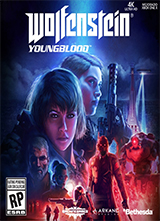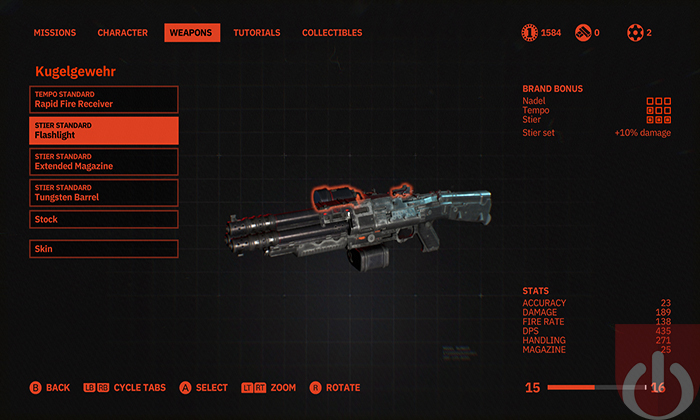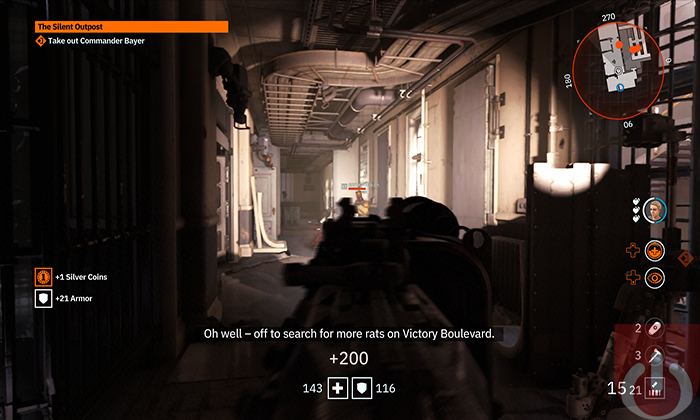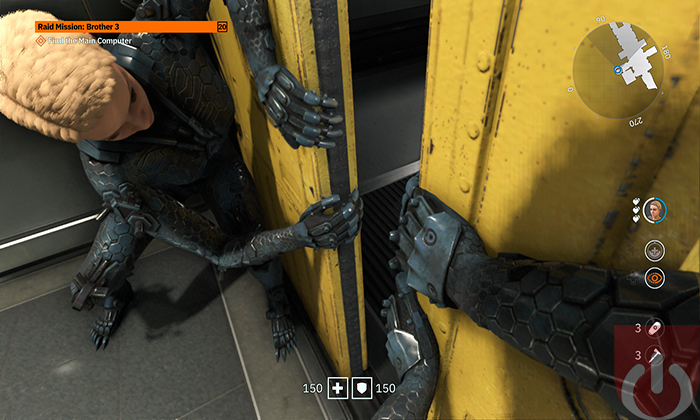Wolfenstein: Youngblood
Wolfenstein: Youngblood is not the follow up to Wolfenstein II: The New Colossus that I wanted. A fact independent of its classification as a spin-off. Cooperative play, large open environments, new protagonists – numerous trailers depicted a promising change in scope. Not a proper sequel, but something engaging for long time fans. No one expected Youngblood to be an underwhelming shooter.
Things don’t start off rocky though. Opening years after the events of the previous game, players are introduced to Jessica and Sophia Blazkowicz (B.J. and Anya’s twin daughters). It’s apparent that the U.S. is no longer under Nazi control. Still, to be on the safe side, the twins are taught how to defend themselves. For a while there, things seem rather dull; for once, the Blazkowicz family isn’t at war. That all changes when their father goes missing.
With the help of a childhood friend, the twins are able to find a clue pointing them to B.J.’s last known whereabouts: the catacombs under a Nazi controlled France. What follows is an eventful romp across a segmented portion of Paris. Thanks to an underground resistance group, the twins are able to search for their father via the catacombs, popping up on the surface near points of interest. A firefight ensues moments later. With Nazi soldiers patrolling the streets and numerous check points housing guards ready to sound an alarm, it never takes long for the shooting to start.
Combat in Youngblood mostly resembles the action found in recent Wolfenstein games. Flying drones peppering an area with rockets, laser-toting robots exploding upon death, and Nazi super soldiers stomping through gunfire. And of course, shotguns still send bodies and their parts flying through the air. The action-packed fights are often chaotic, always absurdly violent, and usually entertaining. They are also a source frustration. The Nazi forces are tough. Their resiliency isn’t based on their smarts though. While it can be difficult to kill an entrenched group of enemies, much of the game’s difficulty has to do with the its two armor variations.
Higher leveled foes will either have a Hard or Soft armor type, unlike the lower level counterparts who have only a single life bar. Certain weapons are better suited to tackle one or the other; a gun that’s great against Hard armor will struggle against Soft and vice versa. The goal (assumedly) was to keep players on their toes by forcing them to switch between weapons during combat.
Unfortunately, this system has a tendency to put them at a disadvantage while fighting. Some weapons are inherently better than others at performing specific tasks. The sniper rifle is great at quietly taking down enemies from afar while the shotgun is better suited for close ranged targets. There are times though, when the player will need to use the sniper rifle up close because of an enemy’s armor type.
This scenario negates the gun’s best attributes, effectively forcing the player to use it at the wrong time. A slow firing, long-ranged weapon isn’t the best choice against a quick, close-ranged target. The restraints of this combat system is especially effective at inducing rage when encountering certain bosses. An already lengthy boss fight can become unnecessarily long deepening on a weapon’s overall damage output, even when using the “right” one.
Now to be fair, there are several weapons assigned to each armor type. And all of them are able to be upgraded using coins found in the environment or taken from dead bodies. Everything from different scopes or grips to larger magazines and battery packs can be purchased on the go. Players won’t be able to completely change a weapon’s functionality though. That said, they’ll be able to augment them in ways that might make them more appealing in less than ideal situations.
There’s also the fact that players are never fighting alone. During solo play, the game controls one of the sisters in a surprisingly competent fashion. They’ll revive the player, change to the appropriate weapons, and utilize special team maneuvers – like encouraging each other to boost their collective health points – whenever possible. They’ll even stay hidden when the player is trying to be stealthy. Of course, cooperative play is where it’s at. Nothing beats playing with another human. And with Youngblood’s buddy pass system, it easier than ever to pull a friend into the action; deluxe edition allows friends who don’t own the game, to join in on the fun.
Again, the combat found in Youngblood is generally entertaining. The content between such happenings is where things truly falter. Take the alternate 1980’s Paris setting for example. Gone are the linear levels and branching corridors of old. In their place is a large, open world environment that acts as a hub to the game’s different missions. It’s similar to the open environments featured in games like Dishonored. The problem is that the Youngblood’s version of Paris is nowhere near as charming or as sophisticated (design-wise) as what’s found in that series.
There are some nice details here and there. Eighties pop culture is twisted to fit this alternate universe. There are surreal representations of Parisian landmarks and some war-torn sections as well. Most of it blends into one another though. Caged in by large metal walls, a lot of Paris is gated off. Multiple roads and alleyways lead to dead ends, sans a few housing hidden collectibles. The emphasis placed on vertical pathways and covert nooks makes navigating around the city unnecessarily confusing; players won’t find themselves completely lost for hours on end, but it’s possible to get turned around several times while heading towards a side mission.
The areas housing the main story missions tend to fare a little better. These linear environments are akin to older Wolfenstein levels. Even with diverging paths and doors that require special weapons to unlock, these levels better utilize their given space. It’s hard to get lost. They also don’t blend in with one another as much; their color palette doesn’t mainly consist of gray.
That said, the missions themselves aren’t that great given their repetitive nature. Through most of the game, the twins are breaking into heavily guarded towers to gain access to super computers. The goal is to use them to decipher a coded message that might shed light on B.J.’s whereabouts. Before they can do so, they’ll need to take down two commanding officers and steal their access keys. Each tower’s layout is different. All of them eventually lead to the same scenario. A shootout on the top floor, stolen keys, and then an escape.
What really makes the story missions tough to enjoy are the lack of check points. Dying on one of these levels means starting over from the beginning. Worse still is the game’s refusal to resupply ammo after respawning; players will have to battle their way back through the level with less than what they started with. Heaven help them if the guns lowest on ammo are the ones needed to deal with majority of the enemies’ armor types.
Youngblood struggles in several areas. The most damning of which is in its narrative. The newer Wolfenstein games were increasingly more story driven. With absurd happenings smashed up against whacky, yet charming characters; their roles are played earnestly, despite the grindhouse-like vibe. That’s not the case with this game.
The awesome balancing of extremes that somehow worked to tell a compelling story has been left by the wayside. In its place is a shallow, by the numbers approach that bearly registers as a plot. Besides the twins – who’re able to showcase their distinct personalities, if only briefly – there aren’t any worthwhile characters. The central villain is extremely forgettable. And most of the cutscenes are held for the beginning and end of the game.
In terms of action, Wolfenstein: Youngblood is decent; it does feature the same over-the-top/brutal gunplay the series is known for, the newly introduced armor system notwithstanding. Sadly, the game frequently misses the mark on every other popular aspect of this series. The result is an entertaining, yet mostly forgettable experience. A game that sits awkwardly between The New Colossus and whatever comes next.
Gameplay:
6
Wolfenstein: Youngblood has its moments. Unfortunately, when the bullets aren’t flying, it fails to live up to its more recent predecessors.
Graphics:
7
The game doesn’t look bad. Paris has seen better days though.
Sound:
8
The voice work, music and sound effects are good.
Replay Value:
3
There are extra, weekly missions to do once the credits roll. Beyond that, there’s no reason to keep playing.
Final Score:
6





